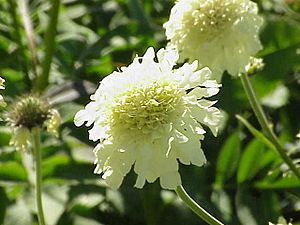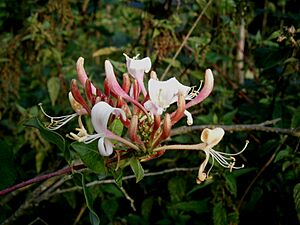Dipsacales facts for kids
Quick facts for kids Dipsacales |
|
|---|---|
 |
|
| Dipsacus pilosus | |
| Scientific classification | |
| Kingdom: | |
| Division: | |
| Class: | |
| Order: |
Dipsacales
|
| Families | |
|
Adoxaceae (moschatel family) |
|
The Dipsacales are a group of flowering plants. These plants are part of a larger group called dicotyledons, which are plants that have two seed leaves when they first sprout. Think of them as a big family of plants that share many features.
Some well-known plants in the Dipsacales order include honeysuckle, elder, viburnum, and valerian. You might have seen some of these growing in your neighborhood or in gardens!
Contents
What are Dipsacales Plants?
Dipsacales is an "order" of plants. In biology, an order is a way to group living things that are closely related. These plants are known for their beautiful flowers and sometimes their useful fruits or roots. They are found all over the world, especially in temperate (mild) climates.
Key Features of Dipsacales
Plants in the Dipsacales order often have flowers that grow in clusters. Their leaves are usually arranged opposite each other on the stem. Many of these plants are shrubs or small trees, but some are also herbs (plants with soft stems).
- Flower Structure: The flowers often have five petals, but sometimes they can have four. They are usually shaped like tubes or bells.
- Fruit Types: The fruits can be berries, capsules, or small, dry fruits called achenes.
- Where They Grow: You can find Dipsacales plants in many different habitats, from forests to open fields.
Famous Members of the Dipsacales Family
Let's look at some of the most famous and interesting plants that belong to the Dipsacales order.
Honeysuckle Plants
Honeysuckles are climbing plants or shrubs known for their sweet-smelling flowers. Their flowers are often tube-shaped and come in many colors, like white, yellow, pink, or red. Butterflies, bees, and hummingbirds love honeysuckle flowers because they are full of nectar.
- Common Uses: Many types of honeysuckle are grown in gardens for their beauty and fragrance. Some varieties produce small berries, but these are usually not eaten by humans.
- Growth Habits: Honeysuckles can grow very quickly, climbing up walls, fences, or other plants.
Elderberry Trees
Elderberry plants are usually shrubs or small trees. They are famous for their clusters of small, white flowers that bloom in spring. Later, these flowers turn into bunches of dark purple or black berries.
- Edible Parts: The berries are often used to make jams, jellies, pies, and even elderberry wine or syrup. They are known for being rich in vitamins.
- Medicinal Uses: For centuries, elderberries have been used in traditional medicine for their health benefits.
Viburnum Shrubs
Viburnum is a large group of shrubs and small trees. They are very popular in gardens because they have attractive flowers, interesting leaves, and colorful berries. Some viburnums have flat clusters of white flowers, while others have large, round flower heads that look like snowballs.
- Seasonal Interest: Many viburnum species offer beauty throughout the year, with spring flowers, summer foliage, and autumn berries or leaf colors.
- Variety: There are hundreds of different types of viburnum, so you can find one that fits almost any garden.
Valerian Plants
Valerian is a tall, flowering plant with small, pale pink or white flowers. It's mostly known for its roots, which have been used for a long time in herbal medicine.
- Medicinal Properties: The root of the valerian plant is often used to help people relax and sleep. It's available in many forms, like teas, capsules, or tinctures.
- Strong Scent: The root has a very strong, distinct smell that some people find unpleasant, but it's a key characteristic of the plant.
The Importance of Dipsacales
The plants in the Dipsacales order are important for many reasons. They provide food and shelter for wildlife, contribute to the beauty of our landscapes, and some have been used by humans for food or medicine for a very long time. Studying these plants helps scientists understand more about plant evolution and how different species are related.
See also

- In Spanish: Dipsacales para niños
Images for kids





